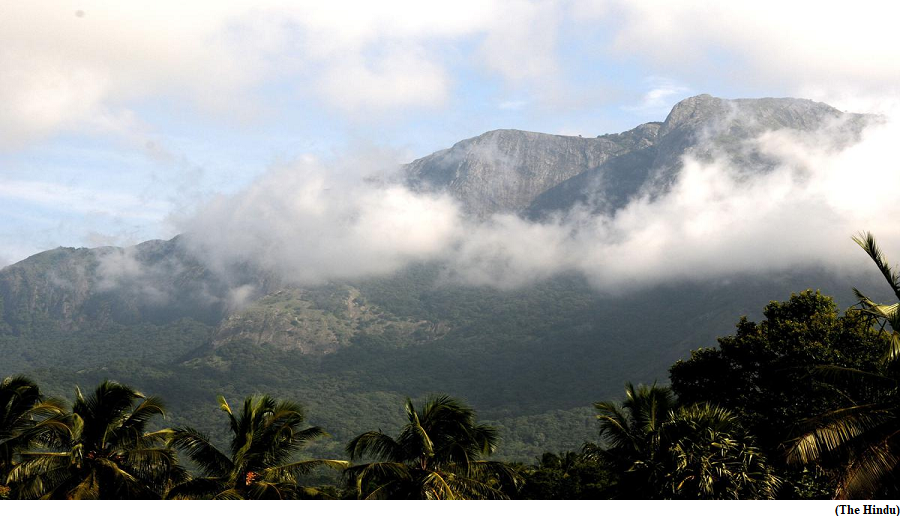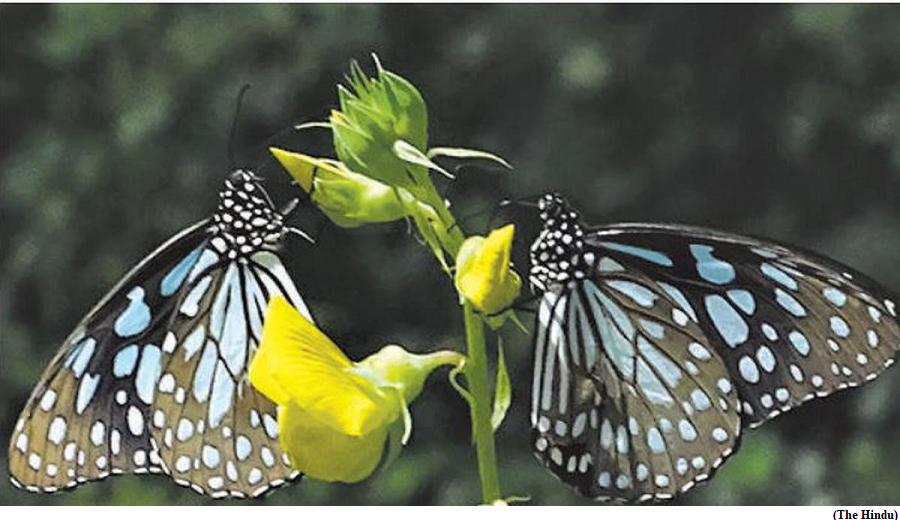A break in the Western Ghats (GS Paper 3, Environment)

Context:
- Often called as a significant discontinuity in the Western Ghats, the Palghat Gap is about 40 km wide, with the steep Nilgiris and Anamalai hills, both rising above 2,000 msl, on either side.
Significance of Palghat Gap:
- The Palghat Gap has historically been important as a significant gateway into the State of Kerala.
- It is a corridor for both roads and railways that connects Coimbatore with Palakkad. The Bharathappuzha River flows through it.
- In contrast to the tropical rainforests of the Western Ghats, the vegetation in the Palghat Gap is classified as dry evergreen forest.
- It also marks a divide in the flora and fauna of the region. For example, several species of frogs are found only on one side of the Palghat Gap.
Origin:
- The Gap is a geological shear zone that runs from east to west. Shear zones are weak regions in the earth’s crust, this is the reason why tremors are sometimes felt in Coimbatore.
- The origin of the Palghat Gap also stems from the drift of continental shelves after Australia and Africa broke off from the Gondwana landmass.
- India and Madagascar remained as one landmass until large-scale volcanic activity split the two, the split occurring where the Palghat Gap is located, this is mirrored in the Ranotsara Gap on the eastern face of Madagascar.
- The landmass split about 100 million years ago, and the Gap had formed before this; although how long before is debated.
Biogeographic distinctions:
- It has been speculated that one reason for the biogeographic distinctions in species in north and south of the Gap could be due to an ancient river or an incursion of the sea in the distant past.
- Elephant populations on the Nilgiris side differ in their mitochondrial DNA from elephants in the Anamalai and the Periyar sanctuaries.
- One study from IISc Bangalore has analysed DNA sequence divergence data in populations of the White-bellied Shortwing, an endemic and threatened bird.
- Birds found around Ooty and Baba Budan are called the Nilgiri blue robin; the Anamalai group differs slightly in appearance, and is called the White-bellied blue robin.
South of the Gap:
- The biodiversity of a region is expressed in two ways: species richness, which relates to how many species are found in an ecosystem, and phylogenetic diversity, where one add up the evolutionary age of all the species found.
- Both these traits are abundant in the Western Ghats south of the Palghat Gap, as reported in a recent study by groups from the CCMB at Hyderabad and other institutions.
- There are over 450 species of trees here, including some such as Magnolia champaca (Champa; Tamil: Sambagan) that have been around for over 130 million years.
Weather:
- Warm weather due to proximity to the equator, and moist air brings plenty of rain to the southern Western Ghats. Therefore, this region has been an island refuge for all forms of life, even as cycles of ice ages and droughts have reduced biodiversity in surrounding areas.
- The Western Ghats in north of the Palghat Gap receive more rain annually, but the south gets rain more evenly throughout the year.
U.K. sees success in mitochondrial replacement therapy
(GS Paper 3, Science and Tech)
Why in news?
- Eight years after the U.K. became the first country in the world to approve a reproductive technique known as mitochondrial replacement therapy (MRT), “less than five” children have been born using the procedure, as of April 2023.
- The Human Fertilisation and Embryology Authority (HFEA), the U.K. fertility regulator that approves the IVF-based procedure on a case-by-case basis, recently confirmed this.
- In 2022, Australia became the second country to approve this therapy.

Three-parent IVF:
- Mitochondria replacement involves transferring nuclear genetic material from a mother’s egg into a donor egg that has had its nuclear DNA removed so the embryo does not inherit the mitochondrial disease.
- This would allow a woman carrying mitochondrial diseases to have healthy children. The resulting IVF embryo combines sperm and egg from the biological parents, while the mitochondria is from the donor’s egg.
- As a result, the baby has DNA from each of its parents, along with 37 genes from the donor. This is the reason why this technique is also called three-parent IVF (in vitro fertilisation).
Significance:
- Mitochondria is the powerhouse of a cell, and any mutation that damages the mitochondria tends to affect energy-hungry organs the most.
- About one in 6,500 babies in the U.K. is born with a mitochondrial disorder which can lead to serious problems such as heart and liver disease, and respiratory problems, which can even lead to the death of the infant.
- In 2013, that this procedure can save around 10 lives each year in the U.K.
Study on butterflies migration opens door for conservation
(GS Paper 3, Environment)
Why in news?
- A recent study by a team of researchers has shed light on the migration patterns of milkweed butterflies in southern India.
- It has the potential to contribute to the conservation of these butterflies and their migration in the face of ongoing changes in land use, habitat degradation, and climate warming.

Migration by milkweed butterflies:
- After southwest monsoon, milkweed butterflies migrate westward from the Eastern Ghats and plains to the Western Ghats, becoming active for more than two months upon their arrival.
- Between October and April, most of the milkweed butterflies in the Western Ghats congregate in large numbers at specific sites during winter and dry seasons. When the summer rain cools southern India, the butterflies migrate eastwards into the Eastern Ghats and the plains.
Key observations:
- The studies reveal that the wings of the majority of butterflies during their eastward journey are battered than that in the westward migration.
- Also, they found that the dominant species involved in the migration, Dark blue tiger and Double-branded crow, are not found breeding in the mid and high-altitude evergreen and semi-evergreen forests of the Western Ghats.
- The adults of Dark blue tiger and Double-branded crow that arrived in the Western Ghats may be migrating reversely and breeding in the Eastern Ghats and the plains of southern India.
Vital role:
- The migration of milkweed butterflies also plays a vital ecological role during the migration. As pollinators, their movements can impact entire ecosystems. Their migration is threatened by habitat destruction and climate change.
- Studying their migration patterns and feeding habits can throw light on the interconnectedness of plant and animal life.
Way Forward:
- Unravelling the mysteries of their migration, can help protect these beautiful creatures and their ecosystems.




